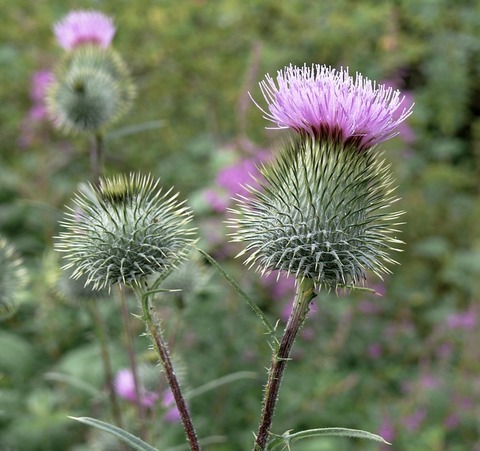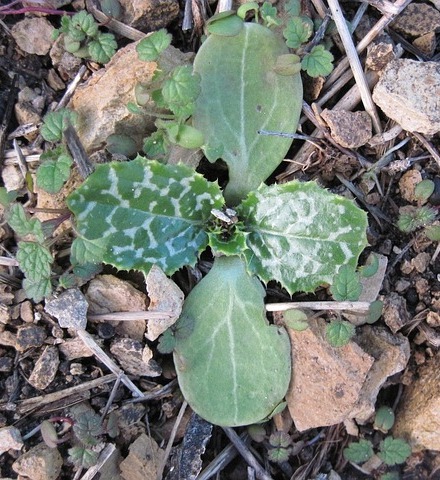Milkthistle; Silybum

This is about milkthistle, and its hormonal properties for breast enlargement and hormonal health. Milk thistle has a folklore history of being used as a lactogogue.
Etymology
The genus of Silybum is known as milkthistle. The species Silybum marianum goes by blessed milkthistle and wild artichoke.
Milkthistle belongs to the Asteraceae or Aster family.
There are many herbs named thistle in various genus within the Aster family. Bull thistle (Cirsium arvenase), musk thistle (Carduus nutans), scotch thistle (Onopordum acanthium), distaff thistles (Carthamus), blessed thistle (Cnicus), globe thistle (Echinops), carline (Carlina) are a few.
Dandelion (Taraxacum), sunflower (Helianthus) and chamomile (Chamomilla) are also within the Aster family.
Properties

Constituents of interest
Silybum contains high amounts of silymarin. Silymarin contains isosilibinin, silibinin, silicristin and silidianin. Silibinin is made up of silybin A and silybin B. Silymarin and its components are flavonolignans: which is a molecule of a phytoestrogen attached to a lignan.
Blessed milkthistle also contains lesser amounts of silitidil, flavonoids (kaempferol and naringenin), and sterols (stigmasterol and sitosterol).
Published studies
Blessed milkthistle's (Silybum marianum) phytochemicals provide varying responses.
Silitidil increases prolactin.
Many constituents of silymarin have anti-cancer, antioxidant and liver protecting properties. Silybins antagonize prolactin response, and modulate ERα and ERβ likely in different ways. Silichristin is a progstalglandin antagonist.
Anecdotal evidence
Thistles used once during menstruation has a long lasting effect causing irregular and extended menses. It causes mixed results, which vary depending on which companion herbs are used with it.
Silybum behaves estrogenic, and like it doesn't have an estrogen antagonist property. In other words, milkthistles contains a lignan like constituent, but it requires a lesser amount of another herb that contains lignans.
The effect of thistles increasing prolactin is likely during luteal phase.
Use
Silybum for breast enhancement
Silybum is a better replacement for clover. Milkthistle should be avoided during proliferative, menses and ovulation. Despite that Silybum contains molecules which are phytoestrogens attached to lignans, it still can use small amounts of sunflower or barley for their lignan content.
The best time to use thistles is during luteal phase, when there's no swelling or bloating present. Thistles can also be used when there's acne present during this phase, with fenugreek as a companion herb.
Thistles01 is an obsolete specific herbal program that was based around thistles in use and in theory.
Silybum or herbs with similar properties are in herb programs based on menstrual phases. There must be balance throughout phases, and combinations of herbs help the body acheive balance for health, breast growth and hip growth. It's important that menses is light and short. Also, preventing an excess of negative symptoms for menses helps set the balance for proliferative phase. Luteal phase uses a different combination of herbs than proliferative phase for symptoms. For a simplified herb schedule, where there's commonality of herb recommendations for symptoms such as swelling and signs of excess estrogen, use nonmenses. BCP01 is a composite page of pieces of different programs on birth control or IUD use.
Herb timing and combinations' success for breast enhancement relies on menstrual phases. Descriptions and pictures of results from herb combination use can be seen in programs. For more guidance, see guide, or hirsutism-topic.
Similar herbs
Other thistles within the Aster family are used for similar purposes. Their active constituents vary, and their effects may also vary.
Sunflower seems to sensitize ERβ. Dandelion is useful for its nutritional value, and there is not enough information available on its properties compared to sunflower or milkthistles. Dandelion, sunflower and chamomile belong to the thistles family.
Herbs containing both phyto-progestins and phyto-estrogens like Suma and Asparagus are possible replacements for thistles.
Precautions
Be sure you properly identify the species of thistles as edible. Many species of thistles are thorny. Also, be aware that Silybum and possibly other thistles typically grows near poisonous plants.
See precautions for more details of care to be taken with herb use. Proper nutrition is a consideration for health. Also, check for the latest blog updates about herb and hormone safety.
It is very important that menses be light and not prolonged.
If you have hirsutism, PCOS, hot-flashes, other signs of hormone imbalances, see estrogen-imbalance, and hirsutism program journals at hirusitism-topic before trying herbs.
Herb concentrates can be tens of times more potent by weight than herbs in solid form. This can easily lead to hormone imbalances. For this reason, concentrate extracts are not recommended for extended or excessive internal use, especially during fertility years. Concentrates shouldn't be used to overcome plateaus. Another issue with herbal extracts, is that they may not have the full range of properties of the herb. Essential oils are not recommended for breast enhancement. If opting to use herbal extracts, use food grade extracts, with no more than 1 drop at a time diluted in water.
More


For the latest herb programs and how to get started, see: guide. Pictures of breast enhancement can be seen in the program journals of Anon02, Anon08, Anon09, Bubblemelon and Jellie.
For resources on hips and butt enhancement, see: /appendix/hips-butt-enhancement and /appendix/kettlebell.
breast-endocrinology.pdf describes the science of breast development and endocrinology. It also describes symptoms related to hormone imbalances. Biology and hormone imbalances are excerpts from this ebook. breast-endocrinology.pdf uses a Creative Commons (CC BY-ND 4.0) license.
Breast.is blog
References:
- Effect of Silitidil, a standardized extract of milk thistle, on the serum prolactin levels in female rats.. https://www.ncbi.nlm.nih.gov/pubmed/25230499.
- An Herbal Galactagogue Mixture Increases Milk Production and Aquaporin Protein Expression in the Mammary Glands of Lactating Rats. https://www.ncbi.nlm.nih.gov/pmc/articles/PMC4436503/.
- The Long-Term Efficacy of a Galactagogue Containing Sylimarin-Phosphatidylserine and Galega on Milk Production of Mothers of Preterm Infants.. https://www.ncbi.nlm.nih.gov/pubmed/29148822.
- Silymarin BIO-C, an extract from Silybum marianum fruits, induces hyperprolactinemia in intact female rats.. https://www.ncbi.nlm.nih.gov/pubmed/19303749.
- New therapeutic potentials of milk thistle (Silybum marianum).. https://www.ncbi.nlm.nih.gov/pubmed/24555302.
- Anticancer potential of silymarin: from bench to bed side.. https://www.ncbi.nlm.nih.gov/pubmed/17201169.
- Effect of Silibinin on Maspin and ERα Gene Expression in MCF-7 Human Breast Cancer Cell Line. https://www.ncbi.nlm.nih.gov/pmc/articles/PMC5831069/.
- The Natural Agonist of Estrogen Receptor β Silibinin Plays an Immunosuppressive Role Representing a Potential Therapeutic Tool in Rheumatoid Arthritis. https://www.ncbi.nlm.nih.gov/pmc/articles/PMC6107853/.
- ERα down-regulation plays a key role in silibinin-induced autophagy and apoptosis in human breast cancer MCF-7 cells. https://www.sciencedirect.com/science/article/pii/S1347861315000894#%FE%FF%00b%00i%00b%002%007.
- Silybin, a Major Bioactive Component of Milk Thistle (Silybum marianum L. Gaernt.)—Chemistry, Bioavailability, and Metabolism. https://www.ncbi.nlm.nih.gov/pmc/articles/PMC6150307/.
- ChEBI: silychristin. https://www.ebi.ac.uk/chebi/searchId.do?chebiId=CHEBI:9143.
Etymology & Definitions:
- USDA Plant classification: Silybum marianum. https://plants.usda.gov/core/profile?symbol=SIMA3.
- USDA Plant classification: Silybum. https://plants.usda.gov/java/ClassificationServlet?source=display&classid=SILYB.
- The Plant List: Silybum. http://www.theplantlist.org/1.1/browse/A/Compositae/Silybum/.
Resources:
- NIH: Milk thistle. https://nccih.nih.gov/health/milkthistle/ataglance.htm.
- Milk Thistle and Poison Hemlock: The Prickly and the Poisonous. https://dengarden.com/landscaping/Milk-Thistle-and--Poison-Hemlock.
